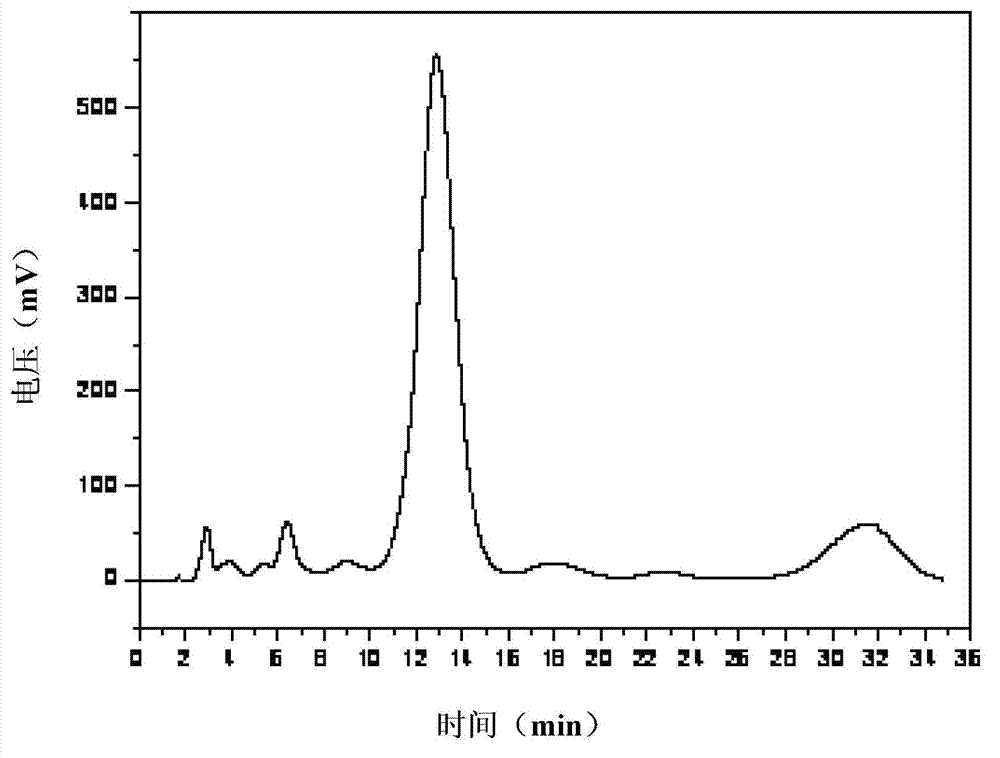Method for separating and purifying EGCG (Epigallocatechin Gallate) by medium-pressure high polymer inversed phase chromatography
A technology for epigallocatechin and gallate, which is applied in the field of medium-pressure polymer reversed-phase chromatography to separate and purify epigallocatechin gallate, and can solve the separation performance of adsorption resin and glucan gel chromatography Poor, C18 bonded silica gel is expensive, dextran gel is expensive, etc., to achieve the effect of not easy non-characteristic adsorption, convenient for industrial continuous production, and non-polar surface
- Summary
- Abstract
- Description
- Claims
- Application Information
AI Technical Summary
Problems solved by technology
Method used
Image
Examples
Embodiment 1
[0039] A 65% ethanol aqueous solution (pH=3.0, acidified with citric acid) with a mass fraction of 65% was used as the mobile phase and a tea polyphenol solution with a mass concentration of 25% was prepared. The solution was passed through a 0.45 μm microfiltration membrane, and the filtrate was collected. The filtrate was ultrasonically degassed (ultrasonic frequency 50HZ) for 30 minutes, and then allowed to stand for 10 minutes. The solution was applied to a CCTRI-1 monodisperse polymer reversed-phase chromatography column, with a sample volume of 3mL, a column length of 26cm, a column diameter of 1.2cm, a filler particle size of 10μm, a column pressure of 10Mpa, and a mobile phase for elution. At 5mL / min, the eluted fractions are collected in sections, the fractions with EGCG figure 2 As shown, the purity of the obtained EGCG is 98.69% by HPLC detection.
Embodiment 2
[0041] A 15% mass fraction of ethanol aqueous solution (pH=4.0, acidified with citric acid) was used as the mobile phase and a 25% mass concentration of tea polyphenol solution was prepared. The solution was passed through a 0.45 μm microfiltration membrane, and the filtrate was collected. The filtrate was ultrasonically degassed (ultrasonic frequency 50HZ) for 30 minutes, and then allowed to stand for 10 minutes. The solution was applied to a CCTRI-1 monodisperse polymer reversed-phase chromatography column, the sample volume was 100mL, the column length was 49cm, the column diameter was 5cm, the filler particle size was 40μm, the column pressure was 5Mpa, and the mobile phase was used for elution. The mobile phase flow rate was 100mL / min, the eluted fractions are collected in sections, the fractions with EGCG image 3 As shown, the purity of the obtained EGCG was 98.1% by HPLC detection.
Embodiment 3
[0043] A 40% mass fraction of ethanol aqueous solution (pH=5.0, acidified with citric acid) was used as the mobile phase and a 25% mass concentration of tea polyphenol solution was prepared. The solution was passed through a 0.45 μm microfiltration membrane, and the filtrate was collected. The filtrate was ultrasonically degassed (ultrasonic frequency 50HZ) for 30 minutes, and then allowed to stand for 10 minutes. The solution was applied to a CCTRI-1 monodisperse polymer reversed-phase chromatography column, the sample volume was 100mL, the column length was 48cm, the column diameter was 6.8cm, the filler particle size was 40μm, the column pressure was 2Mpa, and the mobile phase was used for elution. The mobile phase flow rate At 900mL / min, the eluted fractions are collected in sections, the fractions with EGCG Figure 4 As shown, the purity of the obtained EGCG is 97.6% by HPLC detection.
PUM
| Property | Measurement | Unit |
|---|---|---|
| length | aaaaa | aaaaa |
| particle diameter | aaaaa | aaaaa |
| diameter | aaaaa | aaaaa |
Abstract
Description
Claims
Application Information
 Login to View More
Login to View More - R&D
- Intellectual Property
- Life Sciences
- Materials
- Tech Scout
- Unparalleled Data Quality
- Higher Quality Content
- 60% Fewer Hallucinations
Browse by: Latest US Patents, China's latest patents, Technical Efficacy Thesaurus, Application Domain, Technology Topic, Popular Technical Reports.
© 2025 PatSnap. All rights reserved.Legal|Privacy policy|Modern Slavery Act Transparency Statement|Sitemap|About US| Contact US: help@patsnap.com



